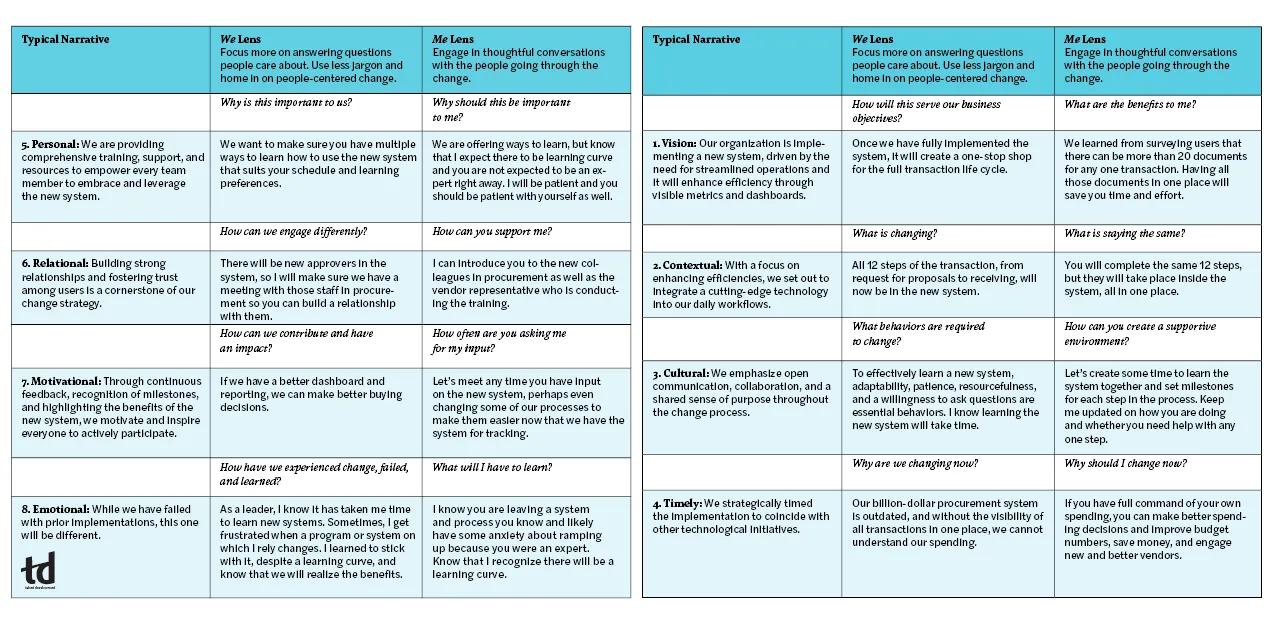TD Magazine Article
Change the Conversation About Change
Building a compelling narrative is essential to a successful organizational transformation.
Sun Sep 01 2024

Change is inevitable in today's fast-paced business environment. However, effectively managing change remains a significant challenge for many organizations. Statistics paint a bleak picture: McKinsey studies show that two-thirds of change efforts fail, and 29 percent of organizations don't even have change support in place. While most senior leaders agree on the importance of communicating the message about change, the real question is: What does that message look like? The answer lies in crafting a compelling narrative.
Narratives enable transformation
When organizations embark on transformation journeys, they often focus on sharing messages about the change—but that is easier said than done. Change management best practices indicate that communicating the message five to seven times is crucial for individuals to absorb it. Further, individuals need to hear the message from people they know and trust, particularly their managers, and it must cascade through the organization. However, leaders themselves often struggle to fully understand the change and communicate it effectively.
Many change initiatives lack a narrative that resonates with employees, leading to confusion, resistance, and ultimately, failure.
In the context of change management, a narrative is a structured and coherent story that explains the change, its reasons, and its impact. It goes beyond mere information sharing to create an engaging and relatable story with which people can connect. A well-crafted narrative addresses both the logical and emotional aspects of change, helping to overcome resistance and build support. Neuroscience indicates that during times of change, the brain experiences stress, making message absorption even more challenging. Leaders involved in the change initiative need to help alleviate that anxiety.
Types of change
Organizations may experience different types of change, such as:
Personal (new roles and responsibilities)
Leadership (new managers and management styles)
Project (new initiatives or projects)
Digital (system implementations)
Redesign (organizational restructuring)
Cultural (mergers or cultural shifts)
Each type can benefit from a tailored narrative that addresses its unique challenges and impacts.
Understanding how people experience change is crucial. The Kübler-Ross change curve model (based on Kübler-Ross's five stages of grief) presents the six different stages of emotional response to change:
Denial (If I ignore this, it will go away.)
Disillusionment or anger (I don't have time for this. This is too much.)
Anxiety or fear (How can I make this work? Isn't the status quo OK?)
Optimism or exploration (So far, so good. Let's try this.)
Acceptance or understanding (I think we can make this work.)
Empowerment (Let's do this. I own this.)
Change management is a systemic, holistic approach to moving people and organizations from a current state to a future state. The right efforts make change easier so people know what's changing and why, see what's in it for them and the organization, have skills and tools to adopt the change, receive positive reinforcement for demonstrating new behaviors, and help to improve the change along the way. An effective narrative can shift the change curve toward acceptance and empowerment, reducing anxiety and resistance.
Eight elements
I support leaders during organizational transformations. In those efforts, I am responsible for communications and training, so I created the narrative framework to help leaders lead change and craft a compelling narrative. To create an effective narrative, it's essential to address eight indicators.
1. Vision. Provide a clear and inspiring vision of the future. This is the most common element used in change communication, but it cannot stand alone.
2. Contextual. Be clear about what is changing and for whom. Understanding the specifics helps people see how the change affects them.
3. Cultural. Identify the behaviors that need to change. As the saying goes, "Organizations don't change; people do." Behavioral change is key to shifting the culture.
4. Timely. Explain why the change is happening now. The timing can influence how people perceive the urgency and importance of the change.
5. Personal. Make the change relevant to individuals' roles and responsibilities. People need to see how the change affects them personally.
6. Relational. Discuss the impact on relationships and dynamics. Change often shifts organizational structures and relationships; addressing that helps to maintain connection.
7. Motivational. Engage people's desire and motivation for change by involving people in the process and ensuring they believe their input is valuable.
8. Emotional. Address emotional responses and anxieties. Change causes significant anxiety, and discussing the emotional aspect helps alleviate fears and build trust. As author Britt Andreatta explains in Wired to Resist, it's necessary to address the deep fears associated with change. Therefore, leaders should share their stories of change, how they handled it, and what they learned. If leaders are willing to be vulnerable, it gives others permission to share their fears.
Key questions
For the typical foundational change management initiative, the lead often crafts a vision. The result is usually a high-level organizational vision that most people cannot connect to and, therefore, cannot imagine how the outcomes will affect them. Sometimes those vision statements may cover the answer to: Why now? But leaders must go deeper, which is the purpose of the narrative framework's fourth through eighth indicators.
The narrative is often different for different leaders in different areas. It's essential for them to make their narrative in their own words, based on their own experiences, and in their own voices.
I tell managers that "We is wonderful, but focusing on me will create momentum." I formulated the framework's first set of questions using we language—which focuses on the leader. The questions correspond with each indicator:
How will this serve our business objectives?
What is changing?
What behaviors are required to change?
What are we changing now?
Why is this important to us?
How can we engage differently?
How can we contribute and have an impact?
How have we experienced change, failed, and learned?
But after shadowing leaders through their change narratives, I noticed that the other side of the conversation was missing. By modifying the questions to also cover me—that is to say, the employee's perspective (keep in mind the phrase "What's in it for me?")—the conversations became richer, deeper, and fuller.
What are the benefits to me?
What is staying the same?
How can you create a supportive environment?
Why should I change now?
Why should it be important to me?
How can you support me?
How often are you asking me for input?
What will I have to learn?
Therefore, to be most effective, narratives must address both sets of questions. To ensure a successful narrative:
Don't limit the narrative to vision.
Focus on all eight indicators because together they establish a comprehensive narrative.
Make the narrative relatable and personal so that people see themselves in the story.
If you are only going to pick one indicator, prioritize addressing emotions (indicator 8). Starting with the emotional component creates a connection, opens the dialogue, and releases anxiety that change can produce.
Let's put the change narrative framework to the test. One workplace change that most employees have experienced is a system implementation. The figure above presents a typical narrative for such a change, plus enhancements in the form of the we and me lenses. As you read column 1 (crafted with the help of artificial intelligence), you likely recognize it as a typical, jargon-filled story of change. It's ineffective because it won't connect with people nor inspire them to change. However, when you introduce the narrative questions for both lenses (columns 2 and 3), the narrative improves considerably because it will support people through change and make the initiative more successful.

Lead the discussion
To truly transform how they approach change, leaders need to change the conversation. Talent development professionals can help.
Ensure better communications. Before the change lead creates the company-wide communication, TD practitioners should interview employees going through the change using the narrative questions as a guide. Doing so will aid leaders in crafting better messages to drive higher awareness and adoption.
Conduct change narrative sessions. Use the framework as a step-by-step process, working directly with leaders to more thoughtfully develop their narratives to share with their direct reports in departmental, team, and one-on-one meetings (especially for individuals who will be directly affected by the change).
Use the framework for conversations. Encourage leaders to apply the narrative framework in daily interactions with their teams. They should use the questions openly and transparently to have a deep, comprehensive discussion. Also suggest that they give the questions to their team members so that individuals can reflect on the change and engage in a dialogue.
By adopting that holistic approach, change initiatives can be more effective and engaging. A well-crafted narrative is a powerful tool in the change management toolkit. It enhances understanding, mitigates resistance, and builds support by addressing both logical and emotional aspects of change. By focusing on all eight indicators, making the narrative personal, and involving people in the process, organizations can create more effective change narratives.

